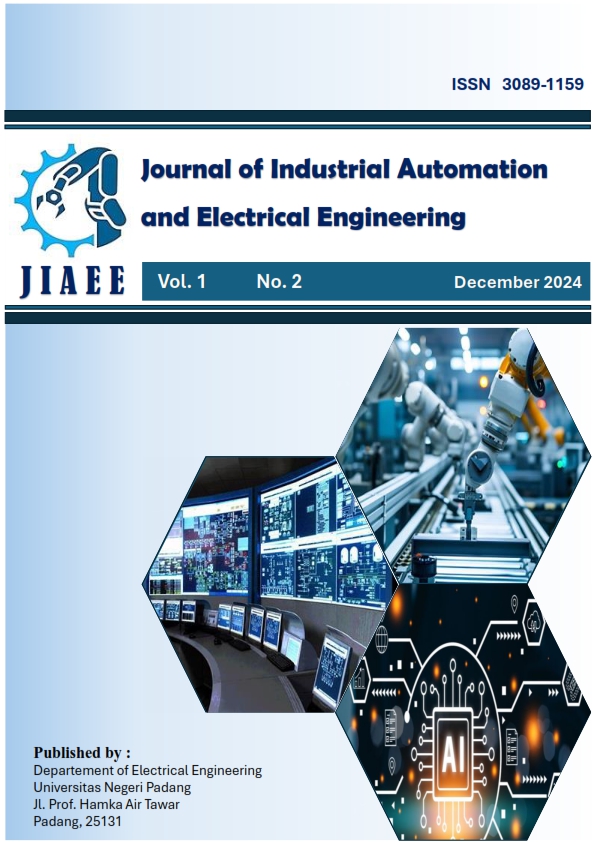Smart belt for the visually impaired to detect obstacles and track position
DOI:
https://doi.org/10.24036/w648fn97Keywords:
Smart Belt , Visually Impaired , LiDAR , GPS , ESP32Abstract
Mobility remains a significant challenge for individuals with visual impairments due to the difficulty in detecting obstacles around them. This study aims to design and develop a Smart Belt to assist visually impaired users by detecting obstacles and tracking their location in real time. The Smart Belt is equipped with a VL53L0X LiDAR sensor to detect frontal obstacles and a NEO-6MV2 GPS module for location tracking. Data collected from the sensors is processed by an ESP32 microcontroller and delivered to the user via a Telegram bot as notifications. Testing results indicate that the device is capable of accurately detecting obstacles and providing vibration alerts, while also successfully transmitting location coordinates to Telegram with satisfactory accuracy. This innovation is expected to enhance the independence and safety of visually impaired individuals in their daily activities
Downloads
References
[1] V. Bharati, "LiDAR + Camera Sensor Data Fusion On Mobiles With AI-based Virtual Sensors To Provide Situational Awareness For The Visually Impaired," 2021 IEEE Sensors Applications Symposium (SAS), Sundsvall, Sweden, 2021, pp. 1-6, doi: 10.1109/SAS51076.2021.9530102.
[2] P. Chavan, K. Ambavade, S. Bajad, R. Chaudhari and R. Raut, "Smart Blind Stick," 2022 6th International Conference On Computing, Communication, Control And Automation (ICCUBEA, Pune, India, 2022, pp. 1-4, doi: 10.1109/ICCUBEA54992.2022.10010707.
[3] S. Ahmed et al., "An Intelligent and Multi-Functional Stick for Blind People Using IoT," 2022 3rd International Conference on Intelligent Engineering and Management (ICIEM), London, United Kingdom, 2022, pp. 326-331, doi: 10.1109/ICIEM54221.2022.9853012.
[4] I. Soliman, A. H. Ahmed, A. Nassr and M. AbdelRaheem, "Recent Advances in Assistive Systems for Blind and Visually Impaired Persons: A Survey," 2023 2nd International Conference on Mechatronics and Electrical Engineering (MEEE), Abu Dhabi, United Arab Emirates, 2023, pp. 69-73, doi: 10.1109/MEEE57080.2023.10127086.
[5] F. Ahammed, M. A. Adnan, M. F. Rahman, N. Alam, H. Paul and Z. A. Jibon, "Development of an IoT-Based Intelligent Guide Stick to Provide Improved Navigation Skills to Blind People," 2023 IEEE 11th Region 10 Humanitarian Technology Conference (R10-HTC), Rajkot, India, 2023, pp. 1106-1111, doi: 10.1109/R10-HTC57504.2023.10461883.
[6] K. Gopal, J. Titoria, A. Uroj and B. Kumar, "Low-Cost Blind-Aid Stick to Prevent Accidents of Visually Impaired People," 2023 International Conference on Device Intelligence, Computing and Communication Technologies, (DICCT), Dehradun, India, 2023, pp. 422-427, doi: 10.1109/DICCT56244.2023.10110195.
[7] P. Sharma, S. L. Shimi and S. Chatterji, "Design of microcontroller based virtual eye for the blind", Int. J. Sci. Res. Eng. Technol., vol. 3, pp. 1137-1142, 2014.
[8] N Sahoo, HW Lin and YH. Chang, "Design and Implementation of a Walking Stick Aid for Visually Challenged People", Sensors (Basel), vol. 19, no. 1, pp. 130, Jan 2019.
[9] D. Isaksson, T. Jansson and J. Nilsson, "Audomni: Super-Scale Sensory Supplementation to Increase the Mobility of Blind and Low-Vision Individuals—A Pilot Study," IEEE Transactions on Neural Systems and Rehabilitation Engineering, vol. 28, no. 5, pp. 1187-1197, May 2020, doi: 10.1109/TNSRE.2020.2985626.
[10] R. R. Bourne et al., "Magnitude temporal trends and projections of the global prevalence of blindness and distance and near vision impairment: A systematic review and meta-analysis", The Lancet Global Health, vol. 5, no. 9, pp. e888-e897, 2017.
[11] F. Barontini, M. G. Catalano, L. Pallottino, B. Leporini and M. Bianchi, "Integrating Wearable Haptics and Obstacle Avoidance for the Visually Impaired in Indoor Navigation: A User-Centered Approach," IEEE Transactions on Haptics, vol. 14, no. 1, pp. 109-122, 1 Jan.-March 2021, doi: 10.1109/TOH.2020.2996748.
[12] H. Vidhya, A. G. K. Sreeram, K. Kiran and K. Karankumar, "Arduino Based Smart Aiding System for Visually Challenged People," 2022 International Conference on Power, Energy, Control and Transmission Systems (ICPECTS), Chennai, India, 2022, pp. 1-5, doi: 10.1109/ICPECTS56089.2022.10047229.
[13] E. J. Chukwunazo and G. M. Onengiye, "Design and Implementation of Microcontroller Based Mobility Aid for Visually Impaired People.", International Journal of Science and Research., vol. 5, no. 6, pp. 680-686, 2015.
[14] R. Radhika, P. G. Pai, S. Rakshitha and R. Srinath, "Implementation of Smart Stick for Obstacle Detection and Navigation", International Journal of Latest Research in Engineering and Technology, vol. 2, no. 5, pp. 45-50, 2016.
[15] P. K. Maduri, A. Kaushal, M. N. Khan, A. Kumar Rai, M. S. Khan and C. Sanjay Rameshwar, "Realtime Aid for Blind Using Python," 2021 3rd International Conference on Advances in Computing, Communication Control and Networking (ICAC3N), Greater Noida, India, 2021, pp. 1660-1664, doi: 10.1109/ICAC3N53548.2021.9725785.
[16] S. Cloix, V. Weiss, G. Bologna, T. Pun and D. Hasler, "Obstacle and planar object detection using sparse 3D information for a smart walker", International Conference on Computer Vision Theory and Applications (VISAPP), pp. 292-298, 2014.
[17] A. F. Ikhfa and M. Yuhendri, “Monitoring Pemakaian Energi Listrik Berbasis Internet of Things,” JTEIN J. Tek. Elektro Indones., vol. 3, no. 1, pp. 257–266, 2022.
[18] E. Cardillo et al., "An Electromagnetic Sensor Prototype to Assist Visually Impaired and Blind People in Autonomous Walking," in IEEE Sensors Journal, vol. 18, no. 6, pp. 2568-2576, 15 March15, 2018, doi: 10.1109/JSEN.2018.2795046.
[19] A. Paulast, N. Prajapati, K. Kharayat, N. Negi, N. Sagar and Iqra, "Assistive System For Blind And Visually Impaired People," 2023 International Conference on Advancement in Computation & Computer Technologies (InCACCT), Gharuan, India, 2023, pp. 1-4, doi: 10.1109/InCACCT57535.2023.10141771.
[20] E. Cardillo, C. Li and A. Caddemi, "Millimeter-Wave Radar Cane: A Blind People Aid With Moving Human Recognition Capabilities," IEEE Journal of Electromagnetics, RF and Microwaves in Medicine and Biology, vol. 6, no. 2, pp. 204-211, June 2022, doi: 10.1109/JERM.2021.3117129.
[21] A. De Leo, P. Russo and G. Cerri, "Electronic Travel Aid for Visually Impaired People: Design and Experimental of a Special Antenna," 2021 IEEE International Symposium on Medical Measurements and Applications (MeMeA), Lausanne, Switzerland, 2021, pp. 1-6, doi: 10.1109/MeMeA52024.2021.9478670.
[22] S. Tejaswini, M. S. Sahana, K. Bhargavi, S. S. Jayamma, H. S. Bhanu and K. S. Praveena, "Obstacle Sensing Assistance for Visually Impaired Person Using Arduino," 2021 5th International Conference on Electrical, Electronics, Communication, Computer Technologies and Optimization Techniques (ICEECCOT), Mysuru, India, 2021, pp. 767-771, doi: 10.1109/ICEECCOT52851.2021.9708054.
[23] V. S. P, K. P, P. G and R. P, "Strategies and Tools for Secure Path Navigation of the Visually Impaired," 2023 3rd International Conference on Pervasive Computing and Social Networking (ICPCSN), Salem, India, 2023, pp. 1220-1225, doi: 10.1109/ICPCSN58827.2023.00206.
[24] F. Al-Muqbali, N. Al-Tourshi, K. Al-Kiyumi and F. Hajmohideen, "Smart Technologies for Visually Impaired: Assisting and conquering infirmity of blind people using AI Technologies," 2020 12th Annual Undergraduate Research Conference on Applied Computing (URC), Dubai, United Arab Emirates, 2020, pp. 1-4, doi: 10.1109/URC49805.2020.9099184.
[25] T. Veiga, E. Ljunggren, K. Bach and S. Akselsen, "Blind Calibration of Air Quality Wireless Sensor Networks Using Deep Neural Networks," 2021 IEEE International Conference on Omni-Layer Intelligent Systems (COINS), Barcelona, Spain, 2021, pp. 1-6, doi: 10.1109/COINS51742.2021.9524276







